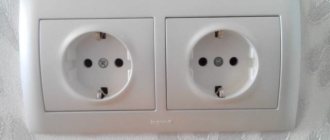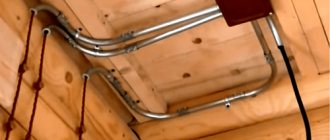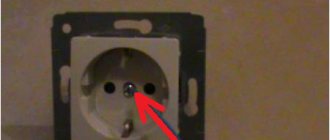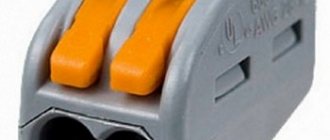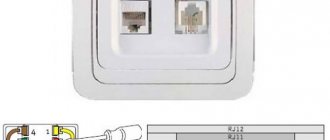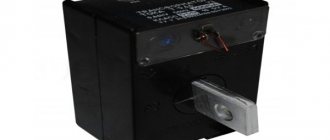Functionality of a grounded outlet
To understand how to connect a grounded outlet, you should know its purpose and why grounding is needed in the outlet.
Almost all household appliances must be grounded - this is required by safety regulations. If electric current gets to the device, with the help of grounding, all voltage will be instantly diverted towards the ground, as a result of which the circuit breaker will operate. In modern apartment buildings, grounding conductors are inserted into the apartment panel and routed throughout the apartment along with the phase and neutral wires. So connecting these 3 wires is all that is needed. It is more difficult to answer the question of how to ground an outlet in an apartment for old houses (“Khrushchev”, “Brezhnevka” and the like). Indeed, in this case, it is necessary to bring the “Earth” into the apartment from the entrance panel. And further, if you want to make all the sockets in your apartment grounded, you will need to completely replace the wiring in the apartment. An alternative option could be wiring hidden in a cable channel.
If a complete home renovation is not part of your plans, but you intend to connect a washing machine, refrigerator or something else in the kitchen and only one grounded outlet is needed, then you can run a cable from the panel to the kitchen along the surface of the wall. Such a cable must be double insulated. For example, PVS wire may be a good choice. Ideally, it is better to hide the wire in a cable channel.
There is a wide range of grounded sockets on the market:
- Built-in/overhead;
- With overload protection (have an internal fuse);
- With current leakage protection;
- Universal;
- With lightning protection;
- With surge protection;
- For very powerful products;
- With mechanical protection.
When choosing a product, it is important to proceed from the type of wall on which it will be installed. It is not recommended to buy sockets with low-quality cheap casings - pay attention to casings made of ceramics.
What is grounding
Connecting wires for grounding in a socket
Electric current is a flow of electrons moving along a conductor under the influence of a magnetic field that creates a potential difference. By the nature of substances, particles move from a positive potential (+), which is called a phase and is applied to technology, to a negative potential (-), called zero. A person, consisting of 70% water, is an ideal conductor of current. The earth has absolute zero potential. If there is a separate line and a buried circuit, it will absorb both leakage and static charge, which will take the path of least resistance bypassing the human body.
What role does it play?
In accordance with the updated GOST, all private houses and apartments must be equipped with grounded sockets with special contacts for the wire that absorbs current leaks in devices. Many do not attach importance to this decision and in vain. In household appliances, internal wires often come off or burn out, after which they touch the body. A Euro socket with grounding takes voltage from the surface of the equipment, discharging it along a separate line into a structure buried in the ground. The resistance of this line is less than that of the human body. This eliminates the possibility of accidents due to faulty electrical wiring of household appliances. Thus, the hidden wiring socket with grounding ensures that the leakage current is reduced to a safe level.
What is the difference between grounding and neutralizing
The difference between grounding and grounding
Not all residential buildings have grounding in sockets. At the same time, there is a need to protect residents from electric shock when using household appliances, especially those equipped with a steel body and installed in wet areas. For this purpose, grounding is used - connecting the body of the electrical installation to the neutral wire. According to its purpose, this solution performs a protective function - preventing a person from being injured by leakage current.
The difference with grounding is that in the event of grounding, when current flows through the body, a short circuit occurs, which leads to the operation of automatic devices installed both on the line and in the device itself. Injury to a person is excluded from the very beginning, since a broken device will be de-energized even before contact with it. You can connect it to the network only after the fault has been eliminated.
What does a socket look like without grounding and with grounding?
What does a grounded socket look like ? The appearance of this type of socket is easily distinguishable due to the presence of 3 metal contacts. To install the outlet correctly, you need to know the features of its design. There are also two types of socket designs - an external socket with grounding and an internal socket with grounding .
Internal sockets are often installed when there is hidden electrical wiring, for example, in modern houses. Nowadays, the electrical goods market is replete with different types of sockets, since previously residential buildings in different countries had their own standards.
A design feature of a grounded socket is that when turned on, the terminals in the grounding circuit first touch, and then the contacts of the neutral and phase wires of the plug enter the socket.
This feature is observed for safety reasons; in the event of damage to the mechanism, its body will be grounded even before voltage is applied to it.
Feature of the socket with grounding
When working with any grounded device, when you connect the plug to a socket, the grounding is activated first, and then the conductive wires, which guarantees complete protection. In terms of appearance, a grounded socket has an additional third contact (protrudes from the top and bottom - see photo), with which the ground is connected.
Before connecting a grounded outlet, it is worth learning the technique of this process.
Socket with grounding 220 V for 16 and 32 A - technical characteristics
If we take the European part of the continent and all of Russia, then the standard voltage (U) in the network is from 220 to 240 V. Conventional sockets are designed for a voltage of 220 V with a load of no more than 3.5 kW.
The operation of such sockets is limited to household appliances of low power and are designed for a current (I) of 16A.
If we take more powerful electrical appliances (electric stoves, ovens and other electrical appliances), then other sockets are provided for them with a maximum current (I) of 32 A and a maximum permissible power of 7 kW.
The AC frequency for Europeans and Russia is 50 Hz, which means that all electrical equipment is designed for this frequency.
The degree of protection from dust (objects) and moisture varies among sockets. Some have no protection at all, and some have IP20, IP44, IP54 and others. The higher the IP, the higher the protection. For example, IP54 - “5” protects from all kinds of objects completely and partially from dust, “4” protects from splashing water.
The following brands of sockets have IP54: EL-BI EVA, ABB EVA, VIKO, EKF, DelUMO and others. Such sockets are installed in damp areas, for example, in bathrooms.
Criteria for choosing wisely
When choosing a grounded outlet, you should focus on products from manufacturers that have proven themselves well in the electrical market. You can safely trust such companies as “Legrand”, “VIKO”, “Bticino”. Among the budget options, but at the same time not inferior in quality, it is worth considering the products of ANAM, Lezard, Makel, Wessen, DKC.
When purchasing accessories from little-known manufacturers, it is easy to get into trouble when the actual value of the rated current does not correspond to the declared value.
The device body must be made of high-quality impact-resistant plastic with high mechanical properties, contacts must be made of good metal
The degree of protection of the product body depends on its operating conditions. Thus, for installation in kitchens and bathrooms, connection points must have a protection level of at least IP44. The first digit of the IP marking, according to international standards, indicates protection from dust, the second – from moisture.
Grounded sockets are available in a wide range on the market. On sale you can find:
- Models with mechanical protection. They are equipped with curtains that cover the sockets and protect from direct contact with the contacts.
- Products with protection against current leakage. As soon as a foreign object penetrates the holes for the plug, the protective shutdown device is triggered - the point is turned off. Such models are often chosen for furnishing homes where there are small children.
- Devices with overcurrent protection, including short circuit protection. The products are equipped with a built-in fuse, which simply burns out if a short circuit occurs.
- Models with surge protection. Devices equipped with a built-in switch automatically turn off when the permissible network values are exceeded.
- For connecting devices whose power exceeds 4 kW. The products, most often surface-mounted, are equipped with a special power plug and are designed for a current of 20-25A.
For indoor connections, you should choose “internal” sockets. They are mounted in specially made niches in the wall.
When planning to install a grounding outlet in the kitchen or bathroom, you should choose products equipped with a plug that covers the holes with contacts
The recommended rated disconnecting current for household devices varies between 30-100 milliamps. Models of domestic brands are designed for 6.3 and 10A, and imported models are designed for 10 and 16A.
When choosing products, pay attention to the size of the inlet holes for the plug and the distance between them. Models from European manufacturers have slightly larger diameters and distances between holes. To avoid mistakes, choose universal models that come with connectors for different types of plugs.
Why do you need grounding in an apartment?
Grounding is a forced connection of electrical installations and equipment to a grounding device. Essentially, grounding is designed to protect humans (and animals) from the dangerous effects of current when insulation breaks down and voltage is applied to the housing.
Suppose a washing machine is connected to an outlet that does not have a ground. If the cable is damaged, the body of the machine is likely to be energized. If a person touches the body, he will receive an electric shock. Extended current can cause serious injury or even death.
But if the outlet is grounded and the grounding itself is implemented correctly, when touching the body of the washing machine under voltage, a person will receive a shock of minimal value (about 0.0008 A), which he most likely will not feel. The current will flow through the grounding wire to the ground. Therefore, outlets must be grounded in every home .
When it is prohibited to connect grounding to sockets
There are a number of rules regarding the safety of electrification of premises.
Their violation can mean only one thing - the creation of a situation fraught with electric shock to people. It is prohibited to connect a hidden wiring socket to grounding in the following cases:
- Damage or rupture of the wire leading to the steel frame buried in the ground.
- The presence of a jumper between the neutral and ground lines.
- Output of the third wire to house communications - water, gas or heating pipes.
Connections can be made only after defects in the electrical wiring have been eliminated.
Types of grounding used
The main terminals for powering the electrical network in the apartment are phase and zero. In this case, there are various options for connecting the neutral wire for protective grounding or only as a return path for current flow. The same applies to the PE grounding wire, which can either have a dedicated core in the overall circuit, be combined, or be completely absent.
All differences in connection diagrams are stipulated in clause 1.7.3 of the PUE rules, so first consider the option that connects the whole house and specifically your apartment. There are six of them in total, but the specific scheme used in your home was laid out at the stage of construction and installation of electrical wiring. Consider the most current power supply schemes for household consumers.
TN-C system.
A special feature of the TN-C system is the power supply using a four-wire circuit, in which three wires are allocated for phase, and the fourth simultaneously serves as neutral and protection. The fourth wire combines the grounding conductor PE and the neutral conductor N, which is why it is called the PEN conductor. When connecting grounding in an apartment using this scheme, there is a serious threat to human life.
Rice. 1: example of an emergency situation in a TN-C system
Look at Figure 1, as shown in the example, in the event of a break in the combined grounding conductor, the following situation will develop for all apartment owners:
- Electrical appliances will stop working - due to the lack of a working zero, the electric current flow circuit will be interrupted (the only exception will be those devices that are powered by phase voltage without using a zero);
- The devices themselves will be at mains voltage potential, since the circuit of electrical devices will still remain intact;
- On the housing and metal parts of devices, grounding contacts of sockets, if they are connected to a combined grounding bus, there will be a neutral wire potential.
As you can see, using such a system for your apartment is not only ineffective, but also dangerous for your life. Therefore, you should not connect the equipment grounding to one conductor with zero. It should be noted that it is impossible to provide protection for an apartment by installing an RCD in such a system, as indicated by clause 1.7.80 of the PUE. Full grounding can only be achieved by converting the circuit to more modern TN-CS or TN-S systems.
TN-CS system.
In practice, the TN-CS scheme is a modern development of the previous TN-C system. Like the previous option, in it four lines are issued from the supply substation to the consumer, of which three are allocated for phase wires, and the fourth for a combined PEN conductor. But, in a certain section of the circuit, the PEN core is broken, and the neutral wire and grounding are separated from it separately. For the latter, a separate grounding circuit is installed at the interface, providing the required amount of electrical resistance to the spreading current.
Rice. 2. Schematic diagram of TN-CS connection
Look at the picture, here is the circuit diagram of TN-CS. A combined PEN wire was laid from the substation to the house. Next, a private grounding loop is installed near the house, from which a PE bus is brought into the house, and the combined bus is used only as a neutral terminal. In this case, the neutral conductor poses a threat to the equipment due to its alignment to the point of separation. Therefore, in order to avoid negative consequences, it is necessary to include an RCD.
TT system.
This system is most common in domestic power supply networks for household consumers. It is characterized by a four-wire power supply, in which three wires are allocated to the phases, and the fourth to a solidly grounded zero.
Rice. 3: TT connection circuit diagram
As you can see in the figure, there is no protective grounding in such a system, so the circuit is organized individually for each house or apartment. After installing such grounding from the electrical panel in the apartment, power is supplied by a three-wire wire (phase, neutral and ground).
Why is grounding needed?
The instructions for any electrical appliance clearly state that it is prohibited to use it without grounding. The main purpose of grounding is to ensure stable operation of complex household devices and protect against electric shock.
According to the PUE clause 1.7.6, grounding is a deliberate connection of one of the elements of an electrical installation with a grounding loop. It is constructed with the purpose of draining currents of values that are damaging or not damaging to humans through the grounding protective conductor into the ground.
If earlier two-core electrical cables were laid in apartment buildings, today it is mandatory to use wiring consisting of three cores
In the outdated system, the “neutral” partially served as grounding. The zero was connected to the metal body of the device, and in case of overload it took over it.
The calculation was that if the load was exceeded, current would flow through one of the phases, resulting in a short circuit and, as a consequence, disconnection of a section of the network by an automatic circuit breaker or fuse. This solution simplified electrical installation work, but carried the risk of electric shock.
The legacy TN-C system does not have a protective earth conductor. For grounding in such cases, a PE bus is required in the apartment panel. If there is no grounding bus, then it is necessary to connect all the panels to each other and connect the entire group to the grounding system of the house - i.e. re-grounding
It is unacceptable to connect devices whose housing is made of metal without grounding. For example: a multicooker, microwave or electric stove. Indeed, if there is a short circuit, thinning or partial destruction of the insulation of the wires on the housing, a current breakdown may occur. If voltage hits a conductive element, the protective conductor will conduct it further to the ground.
No less dangerous is the use without grounding of devices that come into contact with water during operation, for example: a dishwasher or boiler.
The type and design of the grounding contact depends on the model. In sockets of American brands it is presented in the form of holes with side slots. For French analogues, this is an additional third pin.
According to the current rules, new buildings are provided with TN-S or TN-CS systems with a mandatory grounding protective conductor in single- and three-phase power supply systems
But most often you can find the German type of grounding sockets on sale. They are equipped with protruding metal parts on the sides.
The design of an electrical outlet with grounding assumes the presence of three contacts: “phase”, “zero” and “ground”. At the moment of switching on, in the first fractions of a second the grounding terminals come into contact, and after them the “phase” and “0” contacts are connected. This sequence guarantees complete protection.
Externally grounding sockets can be easily visually identified by the presence of an additional metal contact - the “grounding” terminal, necessary for connecting the wire directed from the electrical panel
Connecting correctly
Before installation, you need to determine what type of wiring is in the wall. This step requires removing the old outlet, which will expose the number of wires. If there are only two wires, there is no grounding, and we see only the neutral wire, as well as the phase.
Important: before installing a grounded outlet, it is recommended to ensure that you have the necessary tools for an electrician: an indicator screwdriver and a multimeter.
For correct connection, all stages of work must be followed:
- Turn off the power supply at the panel;
- Carefully inspect the panel and make sure that the electricity is turned off;
- Next, using a special indicator (the so-called indicator screwdriver), you need to make sure that there is no phase on all 3 wires, or more precisely on their bare parts;
- Unscrew the screw on the body, loosen the tabs, remove the old product;
- If the socket box is in poor condition, it can be cleaned or replaced with a new one;
- Remove the external insulation;
- We clean the ends of the wires.
A very important point - always leave a supply of wires, because you will connect them to the outlet BEFORE installing it in the wall!
- Connect the cables to the socket and tighten the screw;
- We connect the third cable to the socket - grounding to the terminal marked as “PE” or with a special sign:
- We fix the case with screws;
- Screw on the housing cover.
Attention! The ground wire is usually colored yellow-green, but always confirm the final conclusion with an indicator screwdriver.
Rules for installing a grounded outlet
Immediately before installation, they determine the network voltage, type of wiring, installation location and wires - zero, phase and grounding.
As a rule, they are distinguished by color - manufacturers use the following markings:
- phase – brown or white;
- zero – blue or black;
- grounding – yellow or yellow-green.
There are two- and three-wire wiring. As a rule, old wiring has two wires, modern designs have three wires.
If you have to deal with old wiring, the task becomes more complicated; you should think about how to ground the outlet - either run an additional bus from the panel, or ground the outlet instead of grounding.
How to ground a double outlet
The procedure for connecting a double socket is exactly the same as for a regular socket, if it is a model for one socket. It has one grounding contact for both sockets, so the part that is inserted into the socket box is no different from the standard device.
laying a grounding wire when connecting several outlets
It’s another matter if a double socket is made up of two ordinary ones located next to each other. In this case, grounding should be considered as made for two separate points and the installation of the grounding wire is carried out somewhat differently than phase and neutral. The difference is that often the connected block of sockets is connected to each other by a cable, when the wires go to the next point from the contacts of the previous one.
If a wire burns out in any place, the next sockets in the circuit will not work. This is not a potential shock hazard like a ground wire that fails. To avoid this, before connecting a double socket made from ordinary ones, the grounding wire is laid in one piece to the last connection point, and twists are made opposite the previous ones, from which the grounding is already applied to the grounding contacts.
How to check grounding in an outlet?
To do this you will need a multimeter and a tester screwdriver. If there are multi-colored wires on the phase, there is black-brown insulation. The test is first carried out with a tester, inserting it one by one into the holes of the socket. The indicator will turn on when you touch the phase.
Subsequently, the presence of grounding is checked with a multimeter. The center or top of the socket (its grounding) is touched with one probe, inserting the second one in turn into its holes.
The absence of voltage between the conductors indicates the following:
- neutral-grounding - about the jumper located between them;
- phase-grounding - about the absence of the latter;
- phase-neutral - about the break of the latter.
If the grounding is working properly, when measuring the voltage between it and the neutral, the device readings should be different from 0, and the maximum result should not exceed 90 V.
Using a multimeter
- Switch the multimeter to AC voltage measurement mode up to 1000 V.
- Measure the voltage between zero and phase.
- Measure the voltage between ground and phase.
- If the voltages of points 2 and 3 differ only slightly, “earth” is present (here we are talking only about its presence, and not about its quality). If there is no voltage in step 3 (the device has not measured anything), the grounding does not function.
Using a lamp tester
- Connect the probe to the phase and neutral. The lamp should be on.
- Connect the lamp to phase and ground. If the lamp burns with the same brightness, there is grounding. If the brightness decreases, the ground loop is in poor condition. The lamp does not light up at all - there is no ground.
Important! If there is an RCD in your panel, when testing the “ground” with a light bulb, it will work, stopping the supply of electricity. Based on this, we can also draw a conclusion about the functioning of the protection system.
Just because you have carefully secured the product does not guarantee that it will work properly. There are cases when during installation the phase is incorrectly secured, as well as the protective contact. To check, we use a special screwdriver with an indicator - we apply it to the phase socket, and the probe to the drive. If the indicator is active, it means there is grounding, and the installation of the grounded socket can be considered complete.
Location of phase and zero
In order to correctly and safely carry out work on installing a grounded outlet, it is important to determine the location of the phase and zero. Before starting the search, you need to turn off the machines in order to de-energize the line or the entire apartment. Next, using a special screwdriver, phase is revealed (the light bulb or neon indicator is illuminated) and zero (there is no light). There will be a ground wire between them.
What to do if there is no ground loop in a multi-story building?
Two ways out of this situation have already been demonstrated (replacing all wiring in the house and installing RCDs). But the last of them provides only instantaneous protection, while working in conjunction with a ground electrode.
Therefore, the correct choice would be to replace two-core cables with three-core ones. It is necessary to install a grounding loop at the back of the house. The distribution of the grounding conductor to individual apartments is carried out using a copper bus having an equal or larger cross-section compared to the PEN conductor, which is included in the cable connected to the house.
Before grounding the outlet, you need to build a protective circuit. Not far from the blind area (at least 1.5 m), triangular trenches are made with sides of 1.2 m to a depth of 0.6 m. An additional trench is dug to the blind area, through which the grounding will be carried out to the distribution cabinet in the entrance.
Metal pipes or corners of small diameter with a length of 2.5 m are hammered into the corners of the triangle.
Their tops are connected by welding a metal bond (steel strips 40x4 mm of the required length).
Then the grounding line from this structure is led to the entrance distribution cabinet:
- from the nearest vertex of the triangle, a steel strip of the same cross-section as that of the metal connection is laid along an additional trench;
- its end is fixed to the house wall with a dowel-nail;
- the installed structure is covered with earth and compacted.
After extending the grounding line to the distribution cabinet in the entrance, each owner will be able to forward their grounding buses to it, connecting them to the main one. By performing these labor-intensive but not complicated actions, they find a solution on how to make grounding in an old house.
How to ground an outlet in a private house
- Let's consider the process using the example of a private house, if there was no grounding wire there initially:
- Installation of a grounding loop. It consists of metal pins driven into the ground, connected at the top points by metal strips welded to them. The length of the pins is 1.5-2 meters, and the length of the metal strips, depending on the type of contour: triangle, ribbon, square or round. To install the circuit, you need to dig a trench 0.5 meters deep.
- Ground connection to the distribution panel. It is made with the same metal strip as for connecting the pins.
- Replacing two-wire wiring with three-wire. If it did not exist before, then it is imperative to install an RCD that guarantees a power outage when voltage appears on the grounding conductor.
- Installation of sockets.
Incorrect connection - what to look for?
When connecting sockets with grounding, the main mistake is installing them on wiring that has two cores. The neutral wire is like grounding. A danger to life is the installation of a jumper from the neutral to the grounding terminal.
This cannot be done for the following reasons:
- if the insulation of the neutral conductor is damaged, a phase short circuit will occur to the equipment body, which will lead to inoperability of the devices, while the socket will appear safe;
- in this system, each core has the same color, which is why the phase and neutral can be swapped, which will lead to phase voltage entering the socket housings.
When connecting sockets with grounding, heating and water pipes cannot be used as the latter. This is due to the fact that if neighbors decide to replace metal communications with plastic ones, a gap will occur, which will result in the formation of stray currents that contribute to the occurrence of electrical injuries.
Socket device with grounding contact
A grounded socket, in addition to two usual contacts for connecting phase and neutral, has one more - for connecting “ground”. That is, it is connected with three wires. The first comes from the machine located in the panel - phase, the second - from the neutral bus, the third - from the earth bus. In this case, the color marking of the wires is usually observed: the ground is connected with a yellow-green wire (sometimes green), the neutral with blue or cyan, the phase can be red, black, brown, etc.
This is what a double grounded outlet looks like without a cover. In this case, the products of the French company Schneider Electric are presented.
If you look at the photo, you will see a copper grounding plate. It can be white if the copper is tinned, but these are more expensive models for use outdoors or in wet areas. The shape of the contacts is such that they look out through the slots in the housing. There is also a contact pad with a clamping screw on the plate - the ground wire is connected here. It's really not difficult.
